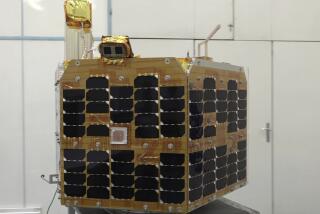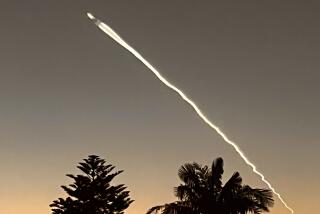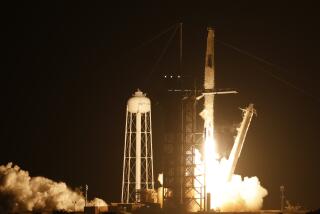Observatory Launched by Rocket : Space: Unmanned mission will use telescope to search the heavens for sources of X-rays. It will also study hot stars, black holes and supernovas.
- Share via
KENNEDY SPACE CENTER, Fla. — With the hobbled space shuttle Columbia standing silent 10 miles away, NASA launched an unmanned rocket Friday with an observatory that will search the heavens for sources of X-rays.
The Delta rocket blasted into a partly cloudy sky at 5:47 p.m. from Cape Canaveral Air Force Station. The $273-million West German observatory, called Rosat, was to be boosted later into an orbit 360 miles high.
“It’s the finest X-ray telescope that’s ever been flown,” NASA program scientist Alan N. Bunner said. “As our instruments improve, it always opens the door to discoveries.”
The launching was delayed about 12 minutes so a commercial airliner could move out of the launching danger area.
There had been some concern early in the afternoon about possible thunderstorms and lightning, but the weather improved and conditions were perfect at launch time. There are fewer weather constraints for unmanned rockets than for the shuttle, which carries astronauts and consequently needs clear skies at landing sites in case of emergency.
Rosat originally was to have flown on a shuttle in 1987 but was redesigned to fit into the Delta after the 1986 Challenger explosion meant waiting until the mid-1990s for a shuttle ride.
About 1,000 sources of cosmic X-rays are known to exist. Astronomers hope 100,000 sources will be identified by Rosat as it orbits high above Earth’s atmosphere, which blocks X-rays and makes them invisible from the ground.
“This will be the fodder that scientists will use for years to come to identify targets for future study,” Bunner said at a news briefing.
The satellite consists of a powerful X-ray telescope and a wide-field camera capable of detecting extreme ultraviolet light.
After two months of instrument calibration, Rosat will begin a six-month survey of celestial bodies that emit X-rays. It will be the first full-sky survey by an imaging X-ray telescope.
After the survey, the observatory will spend the next year or more making detailed observations of extremely hot stars, black holes and remnants of supernovas, hot clouds produced by exploding stars at the end of their lives.
Information will be transmitted to a ground station near Munich, West Germany, and then sent for analysis to centers in that country, the United States and Britain.
Rosat is short for Roentgen Satellite, named after German scientist Wilhelm Conrad Roentgen, who discovered X-rays in 1895.
Rosat is 100 times more sensitive than the best X-ray observatory to date, the so-called Einstein Observatory, which was placed in orbit in 1978, Bunner said. And it will complement the work of the X-ray telescope that is part of the Astro observatory waiting to be launched from Columbia.
The Astro mission has been delayed until mid-June, possibly longer. Columbia’s launching on Wednesday was scrubbed because of a fuel leak. NASA workers Friday failed again to locate the leak.
If the leak cannot be located and repaired on the pad, Columbia will be returned to the hangar.
More to Read
Sign up for Essential California
The most important California stories and recommendations in your inbox every morning.
You may occasionally receive promotional content from the Los Angeles Times.










